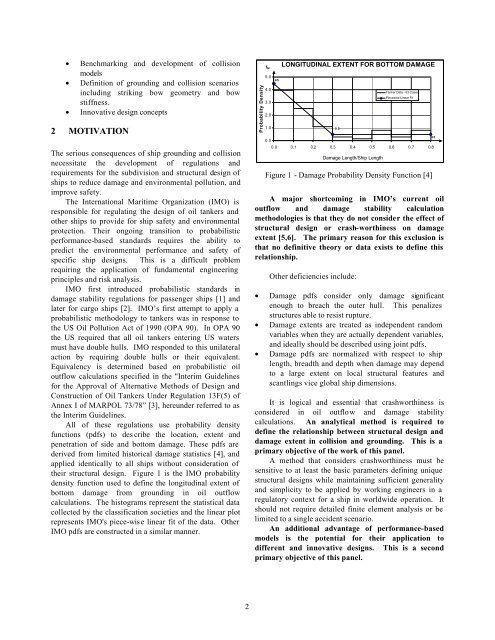Structural Design and Response in Collision and Grounding
Structural Design and Response in Collision and Grounding
Structural Design and Response in Collision and Grounding
You also want an ePaper? Increase the reach of your titles
YUMPU automatically turns print PDFs into web optimized ePapers that Google loves.
• Benchmark<strong>in</strong>g <strong>and</strong> development of collisionmodels• Def<strong>in</strong>ition of ground<strong>in</strong>g <strong>and</strong> collision scenarios<strong>in</strong>clud<strong>in</strong>g strik<strong>in</strong>g bow geometry <strong>and</strong> bowstiffness.• Innovative design concepts2 MOTIVATIONThe serious consequences of ship ground<strong>in</strong>g <strong>and</strong> collisionnecessitate the development of regulations <strong>and</strong>requirements for the subdivision <strong>and</strong> structural design ofships to reduce damage <strong>and</strong> environmental pollution, <strong>and</strong>improve safety.The International Maritime Organization (IMO) isresponsible for regulat<strong>in</strong>g the design of oil tankers <strong>and</strong>other ships to provide for ship safety <strong>and</strong> environmentalprotection. Their ongo<strong>in</strong>g transition to probabilisticperformance-based st<strong>and</strong>ards requires the ability topredict the environmental performance <strong>and</strong> safety ofspecific ship designs. This is a difficult problemrequir<strong>in</strong>g the application of fundamental eng<strong>in</strong>eer<strong>in</strong>gpr<strong>in</strong>ciples <strong>and</strong> risk analysis.IMO first <strong>in</strong>troduced probabilistic st<strong>and</strong>ards <strong>in</strong>damage stability regulations for passenger ships [1] <strong>and</strong>later for cargo ships [2]. IMO’s first attempt to apply aprobabilistic methodology to tankers was <strong>in</strong> response tothe US Oil Pollution Act of 1990 (OPA 90). In OPA 90the US required that all oil tankers enter<strong>in</strong>g US watersmust have double hulls. IMO responded to this unilateralaction by requir<strong>in</strong>g double hulls or their equivalent.Equivalency is determ<strong>in</strong>ed based on probabilistic oiloutflow calculations specified <strong>in</strong> the "Interim Guidel<strong>in</strong>esfor the Approval of Alternative Methods of <strong>Design</strong> <strong>and</strong>Construction of Oil Tankers Under Regulation 13F(5) ofAnnex I of MARPOL 73/78” [3], hereunder referred to asthe Interim Guidel<strong>in</strong>es.All of these regulations use probability densityfunctions (pdfs) to des cribe the location, extent <strong>and</strong>penetration of side <strong>and</strong> bottom damage. These pdfs arederived from limited historical damage statistics [4], <strong>and</strong>applied identically to all ships without consideration oftheir structural design. Figure 1 is the IMO probabilitydensity function used to def<strong>in</strong>e the longitud<strong>in</strong>al extent ofbottom damage from ground<strong>in</strong>g <strong>in</strong> oil outflowcalculations. The histograms represent the statistical datacollected by the classification societies <strong>and</strong> the l<strong>in</strong>ear plotrepresents IMO's piece-wis e l<strong>in</strong>ear fit of the data. OtherIMO pdfs are constructed <strong>in</strong> a similar manner.Probability Densityfb25.04.03.02.01.00.04.5LONGITUDINAL EXTENT FOR BOTTOM DAMAGE0.50.0 0.1 0.2 0.3 0.4 0.5 0.6 0.7 0.8Damage Length/Ship LengthTanker Data - 63 CasesPiecewise L<strong>in</strong>ear FitFigure 1 - Damage Probability Density Function [4]A major shortcom<strong>in</strong>g <strong>in</strong> IMO’s current oiloutflow <strong>and</strong> damage stability calculationmethodologies is that they do not consider the effect ofstructural design or crash-worth<strong>in</strong>ess on damageextent [5,6]. The primary reason for this exclusion isthat no def<strong>in</strong>itive theory or data exists to def<strong>in</strong>e thisrelationship.Other deficiencies <strong>in</strong>clude:• Damage pdfs consider only damage significantenough to breach the outer hull. This penalizesstructures able to resist rupture.• Damage extents are treated as <strong>in</strong>dependent r<strong>and</strong>omvariables when they are actually dependent variables,<strong>and</strong> ideally should be described us<strong>in</strong>g jo<strong>in</strong>t pdfs.• Damage pdfs are normalized with respect to shiplength, breadth <strong>and</strong> depth when damage may dependto a large extent on local structural features <strong>and</strong>scantl<strong>in</strong>gs vice global ship dimensions.It is logical <strong>and</strong> essential that crashworth<strong>in</strong>ess isconsidered <strong>in</strong> oil outflow <strong>and</strong> damage stabilitycalculations. An analytical method is required todef<strong>in</strong>e the relationship between structural design <strong>and</strong>damage extent <strong>in</strong> collision <strong>and</strong> ground<strong>in</strong>g. This is aprimary objective of the work of this panel.A method that considers crashworth<strong>in</strong>ess must besensitive to at least the basic parameters def<strong>in</strong><strong>in</strong>g uniquestructural designs while ma<strong>in</strong>ta<strong>in</strong><strong>in</strong>g sufficient generality<strong>and</strong> simplicity to be applied by work<strong>in</strong>g eng<strong>in</strong>eers <strong>in</strong> aregulatory context for a ship <strong>in</strong> worldwide operation. Itshould not require detailed f<strong>in</strong>ite element analysis or belimited to a s<strong>in</strong>gle accident scenario.An additional advantage of performance-basedmodels is the potential for their application todifferent <strong>and</strong> <strong>in</strong>novative designs. This is a secondprimary objective of this panel.0.52
















